The Quantum Future School Goes to Rennes-le-Chateau (26 of 68)
![[First]](bw_first.gif)
|
![[Prev]](bw_prev.gif)
|
![[Index]](bw_index.gif)
|
![[Next]](bw_next.gif)
|
![[Last]](bw_last.gif)
|

|
|
Alain Féral - a well-known artist who lives in Rennes-le-Chateau - has pointed out, if lines in the shape of an 'M' are drawn between the statues in Sauniere's church, the initials of each - St Germaine, St Roch, St Anthony of Padua, St Anthony the Hermit, and St Luke, spell GRAAL. Above, we see St. Roch. Born at Montpellier towards 1295; died 1327. His father was governor of that city. At his birth St. Roch is said to have been found miraculously marked on the breast with a red cross. Deprived of his parents when about twenty years old, he distributed his fortune among the poor, handed over to his uncle the government of Montpellier, and in the disguise of a mendicant pilgrim, set out for Italy, but stopped at Aquapendente, which was stricken by the plague, and devoted himself to the plague-stricken, curing them with the sign of the cross. He next visited Cesena and other neighbouring cities and then Rome. Everywhere the terrible scourge disappeared before his miraculous power. He visited Mantua, Modena, Parma, and other cities with the same results. At Piacenza, he himself was stricken with the plague. He withdrew to a hut in the neighbouring forest, where his wants were supplied by a gentleman named Gothard, who by a miracle learned the place of his retreat. After his recovery Roch returned to France. Arriving at Montpellier and refusing to disclose his identity, he was taken for a spy in the disguise of a pilgrim, and cast into prison by order of the governor, -- his own uncle, some writers say, -- where five years later he died. The miraculous cross on his breast as well as a document found in his possession now served for his identification. He was accordingly given a public funeral, and numerous miracles attested his sanctity. The legend, not approved by the Vatican, tells us that when St. Roch fell ill of the plague, he was cared for by a stray dog. In time he recovered although he always retained a gaping wound on his right thigh. On returning home his appearance had change so greatly that his family did not recognize him and he was thrown into prison as an impostor where he died. A similar account places the event in Lombardy where he was assumed to be a spy and then sent to prison where he later died. He is often depicted in the company of a dog and is feted on August 16. St. Roch is depicted in his statue as wearing a fine robe. He is seen lifting up the hem of his robe to reveal his right leg which according to legend contained a wound that never healed. It is rather interesting that in some statues of this saint he is revealing his right leg while others the left leg. The wounded thigh imagery has a long history: Zeus lay with Semele, The Moon, and she became pregnant with Dionysius. Hera (Juno) the mother-goddess, furiously jealous of yet another of Zeus’s affairs instigated a fierce argument between Zeus and Semele. Zeus, losing his head, flashed thunder and lightning which consumed Semele, then six months pregnant. The god Hermes rescued his little unborn half-brother by snatching the baby from the fiery lightning which destroyed the mother and then, later, while Zeus was sleeping, place the immature infant inside Zeus’s inner thigh just beneath the warmth of his pendulous sexual organs, there to mature for another three months. At the end of that time Zeus leaned back, spread his Olympian legs and delivered himself of immortal, “twice-born” Dionysius. Then, there is Odysseus. This Greek name is a version of Dyeus. The Romans translated it Ulixes, which seems to be a union of oulas, “wound,” and ischea, “thigh.” As such, the name means “wounded thigh,” “wounded waters,” and — especially since the verb “to burn” in Greek is euo and in Latin is uro — “burned waters.” The very name Europe — i.e. Euro–Pe — seems to mean “wounded-burned-park-rock-home-bird-waters-thigh,” i.e. fire-bird, Phoenix, riser–faller, upper–downer, (quantum) gravitational entity, outer–inner, vagina/womb, Hermes, Mars, Janus. The Hittite god of the winds was likewise born from the thigh of Kumbabi. The thigh seems to correspond to the constellation Ursa Major, which the Egyptians called “The (Bull’s) Thigh.” The name Dionysus - another version of Dione and Dyeus (Zeus)- is thus closely linked to Odysseus. Dionysus is considered “twice born,” “a man with 2 mothers,” “the child of the double door.” We also should note that the Grail King Parzival assumed the lordship of the Grail Castle after his uncle, King Anfortas of the wounded thigh, went on to meet his maker.
|
![[First]](bw_first.gif)
|
![[Prev]](bw_prev.gif)
|
![[Index]](bw_index.gif)
|
![[Next]](bw_next.gif)
|
![[Last]](bw_last.gif)
|